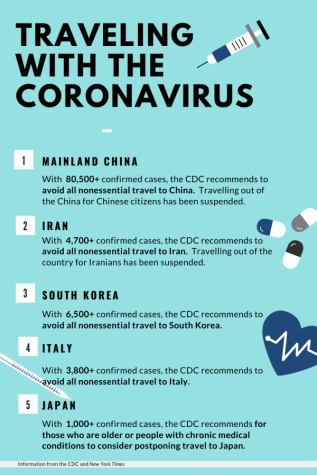Updated: School sends second email to students, staff, and families about the coronavirus
On Feb. 28, the ICCSD sent out a second email regarding COVID-19.
March 6, 2020
On Feb. 28, the Iowa City Community School District (ICCSD) sent out a second email about COVID-19, more commonly known as the coronavirus, saying that they understand families’ concerns and are closely monitoring the situation.
“We want to assure you that we have been and will continue to be working closely with Johnson County Public Health (JCPH) regarding the potential for this virus in our area […] As of February 27, 2020, IDPH has stated that there are currently no cases of COVID-19 in Iowa and the immediate health risk from COVID-19 is low,” the email read.
The first email, sent on Feb. 10, was to school staff and parents only, saying that the district is working with the Johnson County Public Health (JCPH) to watch the virus.
On March 6, the foreign language trips to France and Spain were cancelled due to the outbreak in Europe.
“The Iowa City Community School District announced today that, after reviewing guidance from the Iowa Department of Public Health and consulting with legal counsel, we are recommending all international student trips be postponed or canceled until further notice,” the email read.
The coronavirus is a respiratory disease that causes fever, cough, and shortness of breath 2-14 days after exposure.

“Globally, about 3.4 percent of reported Covid-19 cases have died,” the World Health Organization’s (WHO) general director Dr. Tedros Adhanom Ghebreyesus said in a news conference in Geneva. “By comparison, seasonal flu generally kills far fewer than 1 percent of those infected.”
In the same statement, he also said that the coronavirus does not transmit as easily as the seasonal flu. However, the virus “causes more severe disease,” Dr. Tedros continued.
While the mortality rate inside of China varies between 2-4%, the rate outside of China hovers around 0.7%, according to WHO as of Feb. 24.
On March 6, Dr. Tedros reported that “[i]n the past 24 hours, 2736 cases of COVID-19 were reported from 47 countries and territories. There is now a total of 98,023 reported cases of COVID-19 globally, and 3380 deaths. We are now on the verge of reaching 100,000 confirmed cases.”
Other hot spots for the virus include South Korea, Italy, Iran, and Japan.
In the United States, there have been at least 250 cases, 143 of which are in Washington, Oregon, and California. In the states surrounding Iowa, Illinois has five confirmed cases and Wisconsin has one case, and Nebraska has 13 cases. There have been a total of 14 deaths in the U.S. due to the coronavirus, ten in Washington state and one in California.
As of March 6, 17 total cases have been tested in Iowa. None have tested positive, while 15 have tested negative and two are pending. There are 11 cases being monitored by Public Health that have shown no symptoms of the coronavirus with a total of 40 people having completed Public Health monitoring.
New requirements for testing were announced on March 5. With a doctor’s judgement, any patient that experiences fever, cough, or difficulty breathing can qualify for diagnostic testing.
Government Reaction
The U.S. Congress agreed on an $8.3 billion emergency coronavirus bill on March 4. The bill was passed in a vote, 415 yes and two no. The package includes $7.8 billion for “agencies dealing with the virus.” $500 million was authorized for Medicare providers to provide telehealth services at home for the elderly, who are at risk for the virus.
“Congress is acting with seriousness and sense of urgency the coronavirus threat demands,” Nita M. Lowey, Democratic Representative of New York and chairwoman of the House Appropriations Committee, said. “Strong funding in this legislation is a critical first step to enable a strategic, coordinated and whole-of-government response to the coronavirus.”
$6.5 billion will go to the Department of Health and Human Services, and $25 million of the funds going to states and cities that have spent a substantial amount in fighting the virus. The money would go towards lab equipment, staffing, and other areas.
$2.2 billion is designated for the Center of Disease Control (CDC), $3.1 billion for the Public Health and Social Services Emergency Fund, and $836 million for the National Institutes of Health.
$1 billion of the $2.2 billion allocated to the CDC would go to state and local preparedness and response. Each state is planned to receive at least $4 million.
The Food and Drug Administration (FDA) will receive $61 million, and the State Department and the U.S. Agency for International Development will receive $1.25 billion.
$3 billion of the $8.3 billion package is designated for research and development of vaccines, therapeutics and diagnostics to treat or prevent the spread of the coronavirus.
Ways to Prevent the Virus
The coronavirus is easily transmittable, and stopping the spread is difficult.
“The most basic ways to prevent any illness including COVID-19 are to: wash your hands often with soap and water, stay home if you are sick and remain at home until fever free for 24 hours without the use of medications, and cover any coughs,” suggested school nurse Bethany Carder.
Carder also suggested to see one’s primary care provider if people show symptoms of fever, coughing, or difficulty breathing.
She also said that the school district is in close contact with the Public Health Department and CDC.
“The school district is in close communication with the Public Health Department and the CDC and will follow their recommendations.”
Updated: March 6 at 3:40 pm.


